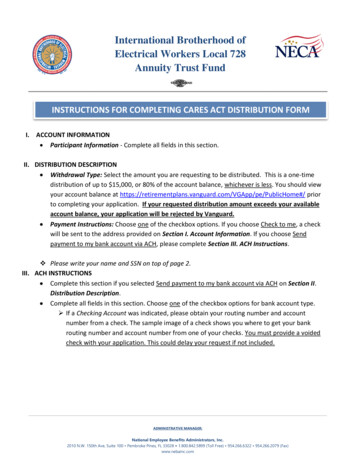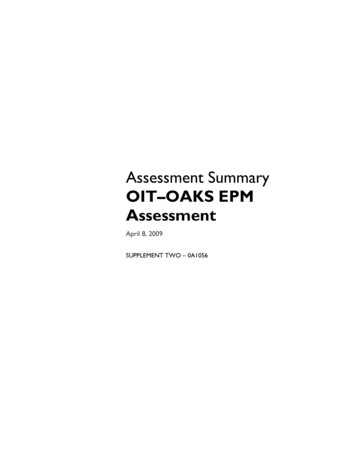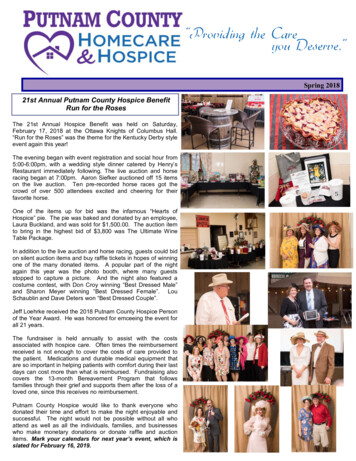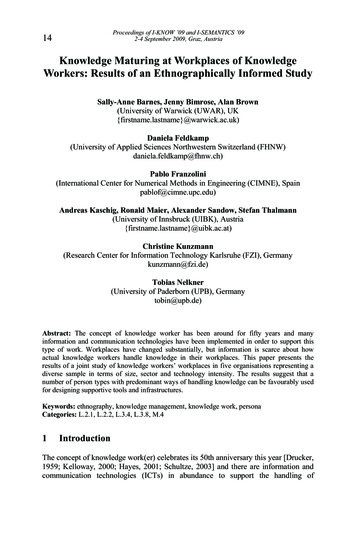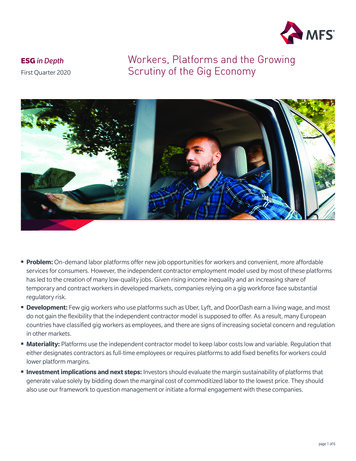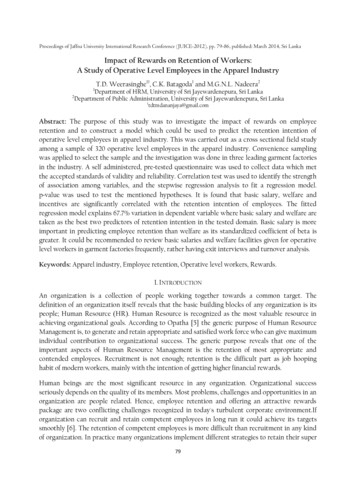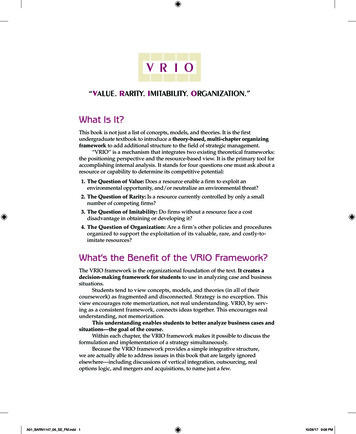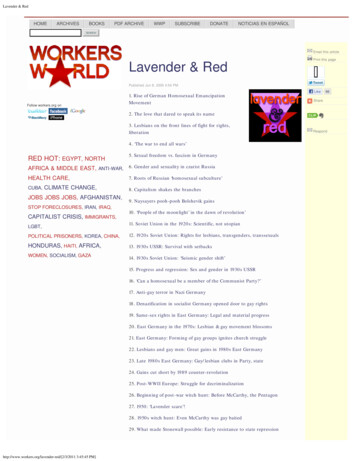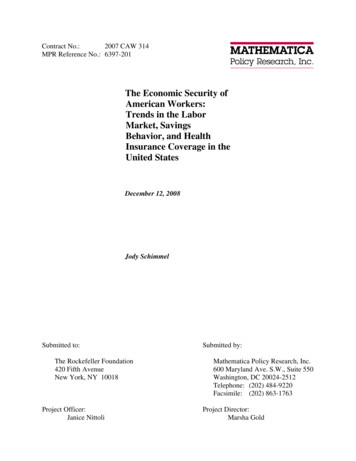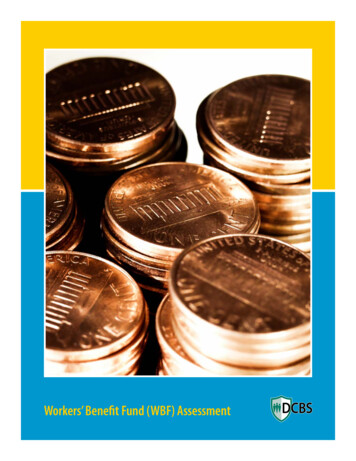
Transcription
Workers’ Benefit Fund (WBF) Assessment
Workers’Benefit Fund (WBF) AssessmentTable of ContentsBackground 2Subjectivity 3Assessment rate 5Determining hours worked 6Calculating the assessment 8Reporting 10Amending forms 12Credit transfer or refund 13Workers’ compensation insurance coverage 14Closing your account 14Additional questions 151
Workers’ Benefit Fund (WBF) AssessmentBackgroundEmployers who maintain workers’ compensationinsurance for themselves, their workers, or bothare subject to three types of payment, each ofwhich sounds similar:The insurance premium — This is thepayment employers make to an insurer forworkers’ compensation insurance coverage.The State of Oregon does not collect insurancepremiums, and insurance premiums do notfund State of Oregon programs or services.zThe workers’ compensation premiumassessment — This is an assessment thatinsurers calculate as a percentage of theinsurance premium paid by each employerand charge to employers as part of theirinsurance billing. Insurers collect the premiumassessment from the employers they covervia the employer’s premium statement, andthen send it to the state. Premium assessmentsfund administrative costs of the state’sworkers’ compensation system, noncomplyingemployer claims, a portion of OregonOSHA administrative costs, and otherrelated programs.zThe Workers’ Benefit Fund (WBF)assessment — This is a payroll assessmentcalculated on the basis of hours worked byall paid workers, owners, and officers coveredby workers’ compensation insurance inOregon, and by all workers subject to Oregon’sworkers’ compensation laws (whether or notcovered by workers’ compensation insurance).Employers report and pay the WBF assessmentz2directly to the state with other state payrolltaxes. The WBF assessment funds stateprograms that directly benefit injured workersand the employers who help make it possiblefor them to return to the workforce.This information addresses only the Workers’Benefit Fund assessment.is the Workers’ Benefit Fund1. What(WBF) assessment?The WBF assessment is a payroll assessmentthat employers of Oregon workers have paidsince 1966. From 1966 to 1994, subject Oregonemployers paid this assessment (then commonlyreferred to as the cents-per-day tax), alongwith their workers compensation insurancepremiums, to their insurance carrier. The insurerthen forwarded the assessment money (not thepremiums) to the state.Then, in 1995, the way in which employers reportand pay this assessment changed. Instead ofpaying this assessment to the state throughtheir insurance carrier, employers began toreport and pay the WBF assessment directly tothe state (along with state withholding taxes,unemployment insurance taxes, and certaintransit taxes) through the Combined Payroll TaxReporting System. Employers report electronicallyonline through Oregon Payroll Reporting (OPRS)at /OPRS.aspx, or by hard copy using aForm OQ or Form OA Domestic. Employers payelectronically using the Department of Revenue’selectronic funds transfer (EFT) program or bycheck and a Form OR-OTC (payment coupon).
Workers’Benefit Fund (WBF) Assessment2. Why am I paying this assessment?The WBF assessment pays for programs thataccomplish the following:Pay monthly cost-of-living increase(inflation) payments to permanently andtotally disabled workers and to the spousesand children of workers deceased as the resultof an occupational injury or diseasezEncourage the employment andre-employment of previously injured orhandicapped workerszOffer Oregon employers monetaryincentives to hire or rehire Oregoninjured workerszMore information about programs funded by theWorkers’ Benefit Fund is available at http://www.oregon.gov/DCBS/Pages/wbf.aspx or by calling800-445-3948 (toll-free) or 503-947-7588.Subjectivityis subject to the3. WhoWBF assessment?Generally, an employer must report and paythe WBF assessment for all people on its payrollwho are or legally should be covered by workers’compensation insurance in Oregon.This includes all employers with workerssubject to Oregon’s workers’ compensationlaws (Oregon Revised Statutes Chapter 656).Each such employer must report and pay theWBF assessment. Whether or not the employerprovides the required workers’ compensationinsurance coverage, the employer is liable forreporting and paying the WBF assessment forall workers for whom Oregon law requires suchcoverage. (In other words, being a noncomplyingemployer does not relieve the employer’s WBFassessment reporting liability.)In addition, any employer of people who performpersonal support work eligible for workers’compensation insurance coverage under HouseBill 3618 (2010) must report and pay the WBFassessment. Independent contractors (in effect,both employer and worker) who perform personalsupport work eligible for workers’ compensationinsurance under HB 3618 are responsible to reportand pay both halves of the WBF assessment.Also, if Oregon law does not require workers’compensation insurance, but the employerchooses to provide coverage, the employermust report and pay the WBF assessment forall people (including owners, officers, and nonsubject workers) who are covered by the workers’compensation insurance. Electing to providecoverage to people for whom coverage is notrequired by Oregon law (personal election)triggers the employer’s liability to report and paythe WBF assessment for each covered person.Exception: Employers do not need to report hoursworked by volunteer workers or pay the WBFassessment for them, even if they are covered bythe employer’s workers’ compensation insurancepolicy. Volunteer workers are workers who donot receive money or receive only nonmonetarycompensation for services rendered.3
Workers’ Benefit Fund (WBF) AssessmentEmployers who have both paid and volunteerworkers covered by their workers’ compensationinsurance policy need to report only thehours worked by paid employees and pay theassessment based only on those hours. Employerswho have no paid employees or who have onlyvolunteer workers, but who maintain activeworkers’ compensation insurance coverage,may either complete a Corrections and ChangesNotification form (http://wcd.oregon.gov/WCDForms/211 158.pdf ) to be exempted fromreporting, or file a quarterly Form OQ to report“0” hours worked and “0” assessment due. Bothoptions prevent receipt of “Failure to File” noticesand possible penalties.is exempt from reporting and4. Whopaying the WBF assessment?Employers are exempt from reporting and payingthe WBF assessment only if all of the followingare true:They are not required by Oregon law tohave workers’ compensation insurancezThey are not (nor have workers whoare) provided with workers’ compensationinsurance under HB 3618 (2010)zThey do not elect to maintain workers’compensation insurance coverage forthemselves or their paid workerszAmong workers exempt from the coveragerequirement are casual labor workers when thetotal labor cost never exceeds 500 in a 30-dayperiod; partners who are also the only workers4for the business; certain corporate officers;volunteers; and workers specifically listed asexempt under ORS 656.027.With the exception of volunteers (who are neverrequired to report and pay the WBF assessment,even if covered by workers’ compensationinsurance), if an employer elects to provideworkers’ compensation insurance coverage for anyof the otherwise exempted workers referencedabove, the employer must report and pay the WBFassessment for all such covered workers.Call 888-877-5670 (toll-free) to speak with acompliance specialist to clarify whether a workeris subject to Oregon’s workers’ compensation lawand the WBF assessment.the employer of a preferred5. Isworker(an injured worker who hasqualified to participate in Oregon’sPreferred Worker Program)required to report and pay theWBF assessment for that preferredworker?Yes. ORS 656.622(10) and Oregon AdministrativeRule 436-110-0325(1) exempt an employerfrom paying workers’ compensation insurancepremiums and premium assessments on apreferred worker for three years from the dateof hire. However, the statute does not authorizeexemption from reporting and paying the WBFassessment. The employer must comply withthe WBF assessment reporting and paymentrequirements of OAR 436-070 for preferredworkers and other subject workers.
Workers’Benefit Fund (WBF) Assessmentis responsible for reporting6. Whoand paying the WBF assessment forworkers in a wrap-up project?A wrap-up project is usually a large constructionproject in which multiple contractors worktogether under one umbrella for severalthings, including covering the cost of workers’compensation insurance. A wrap-up, for workers’compensation purposes, is not the employer, butthe person (loosely defined as an entity) that paysthe insurance on the wrap-up project.Although the wrap-up pays the workers’compensation insurance, each individualemployer continues to have responsibility toreport and pay its WBF assessment. In otherwords, although all contractors involved in thewrap-up project may get their insurance coveragepaid by the wrap-up, each participating employeris responsible for reporting and paying the WBFassessment for any of its workers covered by thatinsurance.Assessment rateis the WBF assessment rate7. Whatfor 2021?The Department of Consumer and BusinessServices has set the WBF assessment rate forcalendar year 2021 at 2.2 cents per hour. The WBFassessment applies to each full or partial hourworked by each paid individual that an employeris required or chooses to provide with workers’compensation insurance coverage. (See Item No.3 Exception above for policy regarding nonpaid/volunteer workers.)This rate complies with the statutory requirementthat DCBS maintain a fund balance sufficient toprovide uninterrupted benefits and services toinsured workers, despite revenue fluctuationsthat have occurred due to uncertain economicconditions. The 2.2 cents-per-hour rate will fullyfund the benefit programs for calendar year 2021.The 2.2 cents-per-hour rate is the employer rateand worker rate combined. Employers contributenot less than half of the hourly assessment(1.1 cents per hour) and deduct not more thanhalf from the worker’s wages. In no case mayan employer deduct more than half of theassessment from the worker’s wages and, in allcases, the employer is responsible for payment ofthe full 2.2 cents-per-hour assessment.8. How is the assessmentrate determined?The Department of Consumer and BusinessServices may adjust the WBF assessment rateas needed to meet stringent fund-balancerequirements. The hourly rate is determined basedon cash balances and projected levels of needof the programs funded by the assessment. Thedepartment provides public notice and mailsa rate notice to employers and payroll serviceproviders in advance of any change to the rate.Call 503-378-2372 for a copy or view the noticeonline at 5
Workers’ Benefit Fund (WBF) AssessmentCalendar YearWBF Assessment RateEmployer’s PortionWorker’s Portion2020-20212.2 cents per hour1.1 cents per hour1.1 cents per hour20192.4 cents per hour1.2 cents per hour1.2 cents per hour2017-20182.8 cents per hour1.4 cents per hour1.4 cents per hourDetermining hours worked9. What is the definition ofhours worked?An hour worked is an hour in which the covered(or not covered but subject) worker, owner, orofficer is engaged in a work activity. The WBFassessment is based on hours or parts of hoursworked. (See below for how to treat partial hoursworked.)10.How are hours calculated?Employers who track actual hours worked(including overtime hours) must use those recordsto determine actual hours and parts of an hourworked.Not all employers of individuals who are salaried,paid on commission, paid “by the piece,” or whowork on an honor system track actual hoursworked and are not required to do so exclusivelyfor purposes of calculating the WBF assessment.If hours are not tracked, choose the method thatensures the most reasonable estimate ofhours worked:Employers who have information availableshowing hours worked, such as a contract,should use this information to determine orreasonably estimate hours worked.z6Employers who estimate hours workedusing a flat-rate calculation should use 173.33hours per month, 40 hours per week, or eighthours per day (prorated for part-time).zIf any method other than actual tracking or theflat-rate calculation without adjustment is used todetermine a reasonable estimate of hours worked,the employer must document the method used incase of an audit.11.Are overtime, leave (vacation,sick leave, paid time off, andholiday), training, orientation,travel, standby, or on-call timehours included as hours worked?It depends.If all actual hours worked are tracked:zInclude overtime hours.zDo not include leave hours.If the person is required by the employer toattend, include hours attending orientation ortraining.zIf the person is required by the employerto travel and is paid for the hours of travel ashours worked, include travel time. (This doesnot include commute time for which thez
Workers’Benefit Fund (WBF) Assessmentperson is not paid by the employer ashours worked.)zDo not include on-call or standby hours.If no tracking system is available to track allactual hours worked, use the flat-rate calculationwith no adjustment for overtime, leave, training,orientation, travel, on-call, or standby hours.12.Workers work part-time. How arehours worked calculated?Either track actual hours worked or, only if hoursare not tracked, use the appropriate fraction of theappropriate flat rate to calculate hours worked.For example, for half-time workers paid weeklyor biweekly, use a flat rate of half of 40 hours perweek to calculate hours worked. For half-timeworkers paid monthly or semi-monthly, use halfor one-quarter of 173.33 hours per month as a flatcalculation. Document the calculation method.13.14.Employer has both part-timeand full-time workers. Can theflat rate be used for the full-timeworkers and actual hours trackedfor the part-time employees?IMPORTANT! The flat rate may not be used foranybody, full- or part-time, whose hours aretracked. However, the employer is not required touse same method for everybody. For example, ifhours are not tracked for full-time workers, but aretracked for part-time workers, use the flat rate forfull-time workers and the actual hours tracked forpart-time workers.Employer has monthly salariedemployees working overtime.Must hours be tracked or maythe flat rate be used?The flat rate should be used if the employer doesnot track and has no way to estimate reasonablythe overtime hours worked. Nothing in the law oradministrative rules requires employers to trackhours exclusively for the purpose of calculatingthe WBF assessment. However, whatever methodis used to calculate workers’ withholdings mustalso be used for the employer’s contributions andvice versa.15.Workers are paid a biweeklysalary. Workers track their hours,but report them to the employersubsequent to each pay period.(In other words, the employerpays ahead.) Where hours aretracked, but reported afterpay, can the flat rate be used tocalculate the assessment or mustthe tracking method be used?If an employer is paying by the hour beforetimesheets are collected, payment mustbe calculated on base hours worked, withadjustments for overtime or leave time made inthe subsequent pay period. The assessment canbe calculated the same way. The assessment maybe based on the base hours assumed workedduring a pay period, and any adjustment toactual hours worked may be used to calculate theassessment in the following pay period.7
Workers’ Benefit Fund (WBF) AssessmentCalculating the assessment16.19.What is a pay period?The assessment is based on hours or parts of anhour worked in a pay period. Use the same payperiod used to calculate the workers’ state andfederal withholding tax. Whatever pay period isused to compute the workers’ withholding mustbe used to calculate the WBF assessment.How are fractions of a centtreated when calculating theassessment portion to bededucted from an individualworker’s wages?Employers have limited discretion in how to roundfractions of a cent when calculating an individualworker’s portion of the WBF assessment.In the product of hours worked multipliedby the assessment rate, fractions of a cent maybe rounded when calculating an individualworker’s portion of WBF assessment. Forexample, a worker who worked 38.5 hours in apay period, 38.5 x .022 0.847. Half of 0.847is 0.424. Because not more than half may becollected from the worker’s wages, the workerportion will be rounded down to 0.42.z17.At the change of a calendar year,what assessment rate is used forpayroll earned in the last quarterof one year, but not paid until thefirst quarter of the next year?Use the assessment rate that applies to the periodin which the payroll is paid, not earned. For payrollearned in December, but not paid until January,the assessment rate used is that which is in effectwhen the payroll is paid.18.How are fractions of an hourtreated when calculating theassessment portion to bededucted from an individualworker’s wages?Do not round fractions of hours worked whencalculating an individual worker’s portion of theWBF assessment. For example, if a worker works38.5 hours in a pay period, multiply the workerportion of the assessment rate by 38.5 hours.820.How are fractions of an hourtreated when summing the totalof all workers’ hours workedfor purposes of reporting andpaying the WBF assessment?When completing the reporting form (Form OQ orForm OA Domestic), round the sum of all workers’hours down to the nearest whole hour.
Workers’Benefit Fund (WBF) Assessment21.How are fractions of a centtreated when multiplyingthe sum of all workers’ hoursworked by the assessment ratefor purposes of reporting andpaying the WBF assessment?When completing the reporting form (Form OQ orForm OA Domestic), round the total amount due(the product of all workers’ hours multiplied by theassessment rate) down to the nearest whole cent.22.Can the employer paythe worker’s half of theWBF assessment?The law provides that it is the responsibility ofthe employer to collect, report, and pay to thestate the full WBF assessment. However, theDepartment of Consumer and Business Servicesdoes not specifically enforce how the assessmentis split between employer and workers as long asthe employer collects no more than half of theassessment from the worker.23.Is the WBF assessment deductedfrom the worker’s wages beforeor after taxes?When the worker portion of the WBF assessmentis withheld from the worker’s wages, it is deductedfrom the gross salary and does not change theamount of withholding for other payroll taxesor deductions.24.Does the Department of Revenueconsider it a taxable benefit if anemployer pays the workers’ halfof the WBF assessment?Yes. The law provides that the employer willdeduct half of the WBF assessment from theworkers’ wages. Therefore, if the employer paysthe workers’ portion, the Department of Revenueconsiders this a taxable benefit to the worker.The Department of Revenue uses the followingexample: A worker’s gross taxable wage is 1,000,and the worker portion of the WBF assessmentis 3. If the employer chooses to pay the totalassessment, the worker’s taxable gross wage isincreased to 1,003. If the worker pays the WBFassessment, the gross wage remains at 1,000 andis not reduced by the amount of the assessment.For more information, contact the Department ofRevenue at 503-945-8091.25.Does the Department of Revenuerequi
The WBF assessment is a payroll assessment that employers of Oregon workers have paid since 1966. From 1966 to 1994, subject Oregon employers paid this assessment (then commonly referred to as the cents-per-day tax), along with their workers compensation insurance premiums, to their insurance carrier. The insurer
